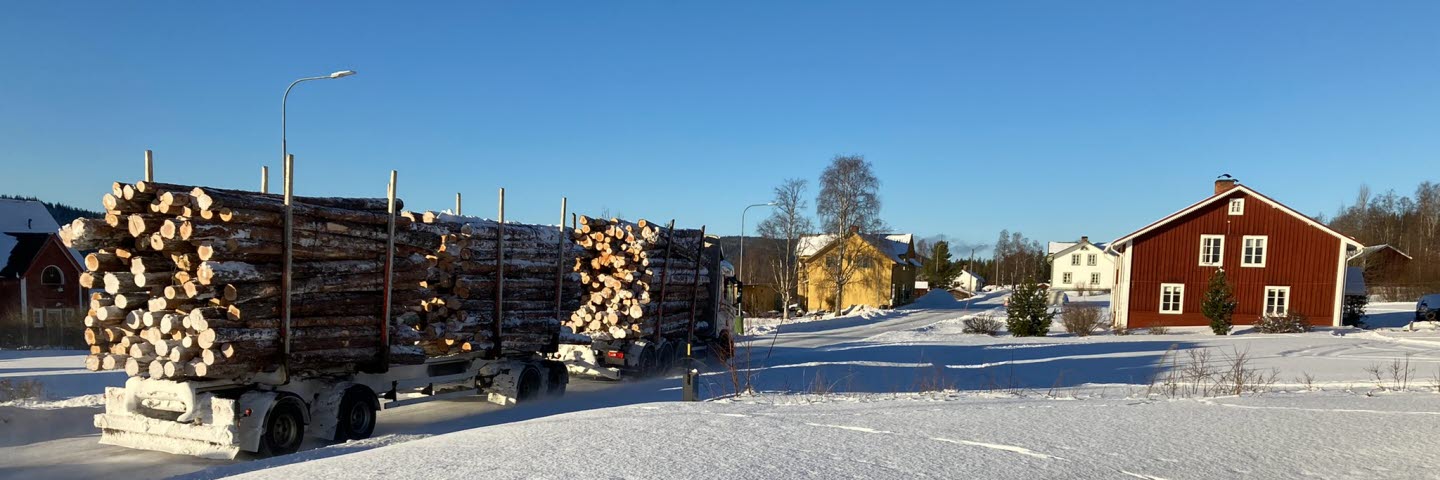SCA testing Geofencing automated speed reduction for safer timber transport
SCA is continuing its efforts to promote safer timber transport in Northern Sweden. SCA and the Swedish Transport Administration are now testing geofencing in about 40 timber trucks that travel along selected roads in Jämtland and Västernorrland. Geofencing is a technology that automatically reduces the speed of vehicles when they enter a specific area. “This is entirely in line with our efforts to promote safe timber transport and to protect the local environments of the areas where we operate,” says Lars Nolander, Logistics Manager at SCA Skog.
SCA Skog has been working extensively to improve the safety of timber transport for several years.
 “Under the heading of ‘Inte en till’ (No more accidents), we’ve been working intensively with safety together with the haulers who drive for us, in regard to how their operators drive and their work environment outside the vehicle. Now it feels like a natural step to also be looking at our local environment and the benefits that geofencing can offer,” says Lars.
“Under the heading of ‘Inte en till’ (No more accidents), we’ve been working intensively with safety together with the haulers who drive for us, in regard to how their operators drive and their work environment outside the vehicle. Now it feels like a natural step to also be looking at our local environment and the benefits that geofencing can offer,” says Lars.
“We have to transport the timber from inland areas to our industries along the coast, and rail freight doesn’t work everywhere,” he adds. “But with geofencing, we can now test a technology that can make it easy for the areas where we operate, so they can feel more secure. It feels really great!”
Geofencing is a service that uses GPS technology to create a virtual boundary or fence, enabling the vehicle to perceive the specific conditions for a specific geographical area as it approaches and enters the area.
Important contribution to road safety
The Swedish Transport Administration has already tested geofencing, but mostly in metropolitan environments. This will be the first time with really heavy traffic, and mainly on roads through small towns. SCA and the Swedish Transport Administration have selected four towns/sections of road: Laggarberg and Järnvägsgatan in the Timrå area, and Rissna and Hällesjö in Jämtland. These sections range from 500 meters to 2.2 kilometers and the programmed speed will be 30-50 km/h.
“These selected areas are particularly sensitive in terms of road safety, with heavy traffic on narrow roads that are close to schools and other buildings. Even though the timber trucks don’t exceed the speed limit, they are perceived as big, heavy and fast and possibly scary when they drive past, so this is an important contribution to the local communities,” says Lars.
Major backing from haulers

Many haulers are taking part in the pilot project.
“We have engaged about 40 timber trucks from four haulers – Fermgruppen in Sundsvall, Bispgården åkeri, Själanders åkeri and Näslunds Transportservice. All of the participants drive Scania trucks with the optional Scania-zone service, which is the technical solution used in this project, ” says Lars.
When the driver of a timber truck enters the geographic area, the accelerator pedal will ‘slacken’ if they are driving faster than the programmed speed for the section. The driver can override the system, however, by fully depressing the accelerator pedal. Nothing will happen if the vehicle is traveling slower than the programmed speed.
“It’s important that the drivers can override the system though, in case they have to accelerate for some reason. But the aim is obviously that it won’t be needed,” says Lars.
“We are working hard to improve safety for our employees. This new technology is an exciting way to improve safety for our drivers, as well as other road users and local residents,” says Petter Näslund, owner of Näslunds Transportservice, which is taking part in the project with all of its five timber trucks and ten drivers.
Sustainable transport
The project will continue throughout 2023 and in addition to testing geofencing in the vehicles, traffic counts will be carried out along the selected sections.
The Swedish Transport Administration will follow up on the drivers’ experience and how often a vehicle overrides the system, but no personal information will be collected, which means that no individual drivers will be monitored. The Swedish Transport Administration will then undertake traffic counts to identify the volume of traffic and the road network users. It will also estimate the potential benefits that geofencing could have for the traffic flow – if all heavy vehicles were to use the system.
“This is the biggest geofencing project in Sweden to date in terms of number of heavy vehicles. Road safety can be improved with simple means. If it works well, the technology can be distributed to more forest industry haulers and companies, as well as other industries,” says Jan Lindgren, senior investigation manager at the Swedish Transport Administration.
“This project is about sustainable transport and sustainable speeds, which we are happy to support and make a reality. It will be very exciting to follow the project,” says Lars.
-
That’s a remarkable amount of work hours for a single machine, the Norcar 600 owned by Erkki Rinne is taken well care of, it even has the original Diesel engine.
-
Kieran Anders is a forestry contractor working in the lake district. His work involves hand cutting and extracting timber using a skidder and tractor-trailer forwarder.
-
It is not possible to eliminate chain shot, but there are simple steps that can be taken to reduce the risk.
-
Arwel takes great pride in the fact that the mill has no waste whatsoever, “the peelings are used for children’s playgrounds, gardens and for farm animals in barns in the winter and the sawdust has multiple uses in gardens and farms as well.
-
Timber hauliers need to encourage young blood in, and also look after the hauliers we have, we need make the sector a safe and positive place to work.
FIND US ON
Related Posts
Forest Machine Magazine is written and edited by a forest professional with over 40 years hands on experience. We are dedicated to keeping you informed with all the latest news, views and reviews from our industry.
To support us you can subscribe to our bi-monthly magazine which is delivered to your door from only £30 per year.
Subscribe here
#homeoflogging #writtenbyloggersforloggers #loggingallovertheworld
-
 Issue 38£6.00
Issue 38£6.00


